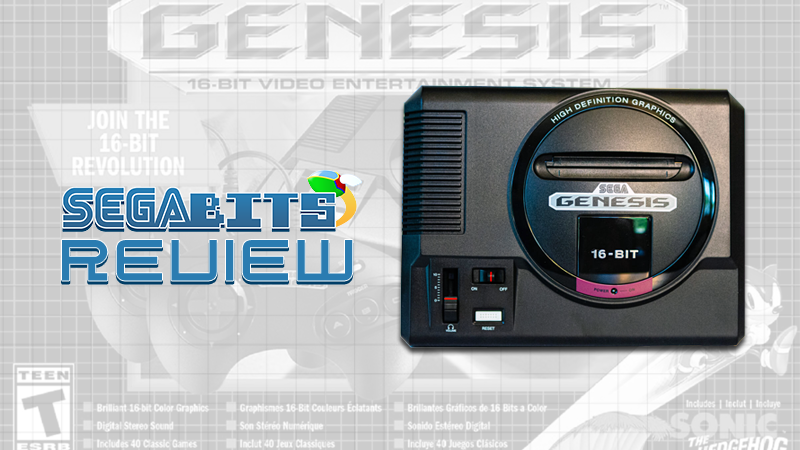
Well it’s the 30th anniversary of the SEGA Genesis (aka the Mega Drive). The SEGA Genesis for decades now has been fondly looked back due to it’s strong kit and solid lineup of games, which is reflected in it being SEGA’s best selling console of all time. While it did eventually stutter late into it’s life, ironically from SEGA themselves trying to expand on the console with peripherals like the SEGA CD and SEGA 32X, those that remember the system back in the day remember SEGA’s aggressive push to outsmart their main competition Nintendo. This resulted in quite a number of notable titles being developed over the years, both from SEGA themselves with their arcade ports and original titles, to other third parties contributing to the system like Compile, Electronic Arts, Capcom, Konami, and Namco.
Now 30 years later due to the “mini console” fad, SEGA is now pumping out a huge love letter in a tiny package, simply called the SEGA Genesis Mini. Will this small machine bring out that nostalgic heart tug, or is it more like an embarrassing memory from ages ago?
Before you even boot up the mini console, the SEGA Genesis Mini already shows it’s charm. The box it comes in being a throwback to the same packaging from decades ago, around the time Sonic the Hedgehog was launched and was being bundled with SEGA Genesis consoles to boost sales. Sonic running off a cliff while advertising Sonic the Hedgehog, the tagline “Join the 16-bit Revolution” being similar to the original tagline “Leader of the 16-bit Revolution”, the SEGA Genesis being displayed in front of a trippy picture bordered by that classic black tiling. A lot of care was put into making the box nostalgic, and that also applies to other regions following a similar pattern.
The console itself is an adorable small recreation of the original model one SEGA Genesis. It is roughly 60% smaller than a normal SEGA Genesis console and obviously much lighter, but none of the quality was sacrificed. It’s made of a solid plastic that gives it some surprising durability, which is very similar to the original material used on the SEGA Mega Drive. Like for example if you rub your fingernails on the surface, the plastic makes a distinct scratching noise like it’s slightly coarse, with both the SEGA Genesis Mini and the original system having this characteristic. The SEGA Genesis Mini also retains a lot of the same functionalities of the original system, like the headphone slider, fully functional power switch, and the slot on the top for cartridges. Most of it is technically pointless, but it’s always appreciative that SEGA was paying attention to the small details. Heck, you can even buy faux SEGA CD, SEGA 32X, and mini cartridges to add to the insanity. Pointless but fun stuff like this is fantastic!
It’s is solidly made, but it has one major flaw due to it being so small. It’s extremely light, which while making sense since it is a miniature replicate, it also means that a lot of the weight was sacrificed, which in turn means that there’s always a risk of you accidentally yanking on the console and sending it flying. I’ve personally had this happen several times, where I simply lightly tugged on the controller, and the system was very easily dragged around on the table. If the system had slightly more weight to it and the bottom having more rubber, this problem would of been fixed easily. However this really small size also means that it’s very portable. You can stick the entire system and the controllers in a purse, and bring it over to a friend’s house to play some co-op games like Streets of Rage II or Toejam and Earl.
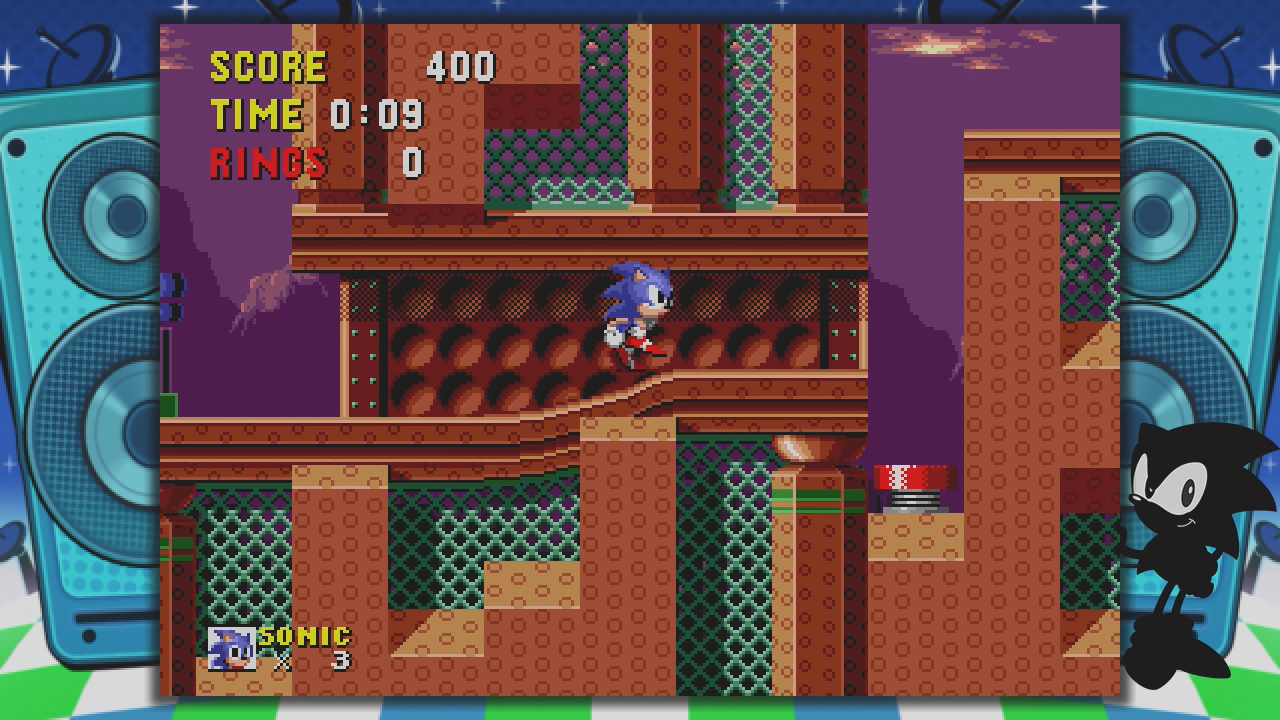
Controllers are pretty straightforward. They’re the standard 3 button controllers that were iconic to the SEGA Genesis, the only difference is that they use USB instead of the 9 pin setup like the original controller. Thankfully the cord itself is reasonable long at 6ft, unlike the NES and SNES mini consoles which felt too short by comparison, which means you don’t need to get stupidly close to the television to play some video games. However while the controller does look very similar to the original hardware, there are subtle differences between the original and this new Mini replica. The thing that stood out to me the most was how the directional pads felt. When pressing on it, it felt more loose than the original directional pad, like it slightly pressed in more. The buttons are similarly feel different, though it could also be a case of the older controllers simply being worn down over time. It’s a very minor difference though, as otherwise the controller is a very faithful recreation and doesn’t hamper or benefit you either way.
The bigger issue is the way the controllers are bundled. With the North American and European consoles, you get two of the three button controllers, while Japan either gets the standard version with only one six button controller or a deluxe version that has two of them. The issue here is that there are several games, most notably Street Fighter II, require the six button controller. When you are given the three button controllers, it basically makes the fighting games in the collection much more impractical, and your only option is to either shill out extra dollars for a six button controller like from Retro-Bit, or importing the Japanese system and having to deal with potentially inflated shipping fees. It’s a pretty glaring oversight in the grand scheme of things, but they likely guessed that no one would mind since most games only needed the three buttons anyway.
Anyway, once you actually start booting up the system for the first time, it immediately hits you with it’s charm. A lot of love went into the main menu alone, with all the small touches helping give it that sense of nostalgia. The main melody was composed by Yuzo Koshiro, a veteran composer in the video game industry who has notably composed music for the Streets of Rage and ActRiser series. The melody itself was made using authentic SEGA Genesis game sound fonts, which if you listen carefully has parts in it that references songs from games such as Sonic the Hedgehog, Phantasy Star IV, and Gunstar Heroes. While the melody plays, all the games are displayed in a straightforward interface, where the boxart of each respective game appears. You have several options to organize these games, such as by release date or alphabetically, and you even have the option to view every single game at once by flipping them over to their spine.
However, the real magic is when you start experimenting with the language settings. Instead of simply changing the language to a decent selection of choices like Japanese, English, French, Italian, Spanish, Korean, Chinese, etc., the entire interface also changes to reflect each region. The main menu will reference the SEGA Genesis in English, but will swap over to different variants of the Mega Drive style depending on the region, like having that white contrasted by abstract colorful shapes from Japan’s Mega Drive or the more subtle blues and blacks like the European’s Mega Drive. Every game will also change their boxart to reflect each region, and even the games themselves will change based on the region. Castlevania Bloodlines will have different names depending on the region like Castlevania: The New Generation in Europe or Vampire Killer in Japanese, Beyond Oasis will have the unique French localization “La Legende de Thor” if you swap it over to the French language, Dr. Robotnik’s Mean Bean Machine will swap over to Puyo Puyo if you set the language to one of the Asian languages, games such as Ecco the Dolphin and Contra Hard Corps will have gameplay changes depending on the region, and so on.
While you browse the different settings, there are a scant amount of picture modes also available for you to try out. The first is a 4:3 aspect ratio, which strangely isn’t technically 4:3. The best way to describe it is that it acts like a hybrid of a 4:3 aspect ratio mode and a “pixel perfect” mode. Basically it assumes that every game on the system is running using the H40 mode, which is 320 x 224 that is then scaled by three times to create 960 x 672 within a standard 720p resolution. Normally this method of scaling works since most SEGA Genesis titles used a 320 x 224 resolution anyway, meaning that problems ranging from screen tearing or shimmering are completely avoided. However, for the few games that instead used a 256 x 224 resolution like Monster World IV and Shining Force, this method of scaling forces these games to be incorrectly stretched slightly. For example, if you play Monster World IV and see the intro with Asha looking into the distance, you’ll notice that her body slightly distorts as the sprite slides to the right due to improper scaling. Some sort of interpolation implemented to soften the edges of pixels could of fixed this issue, but it seems like the developers purposely went with no filters in order to create a sharp picture that looks clean even when scaled by monitors.
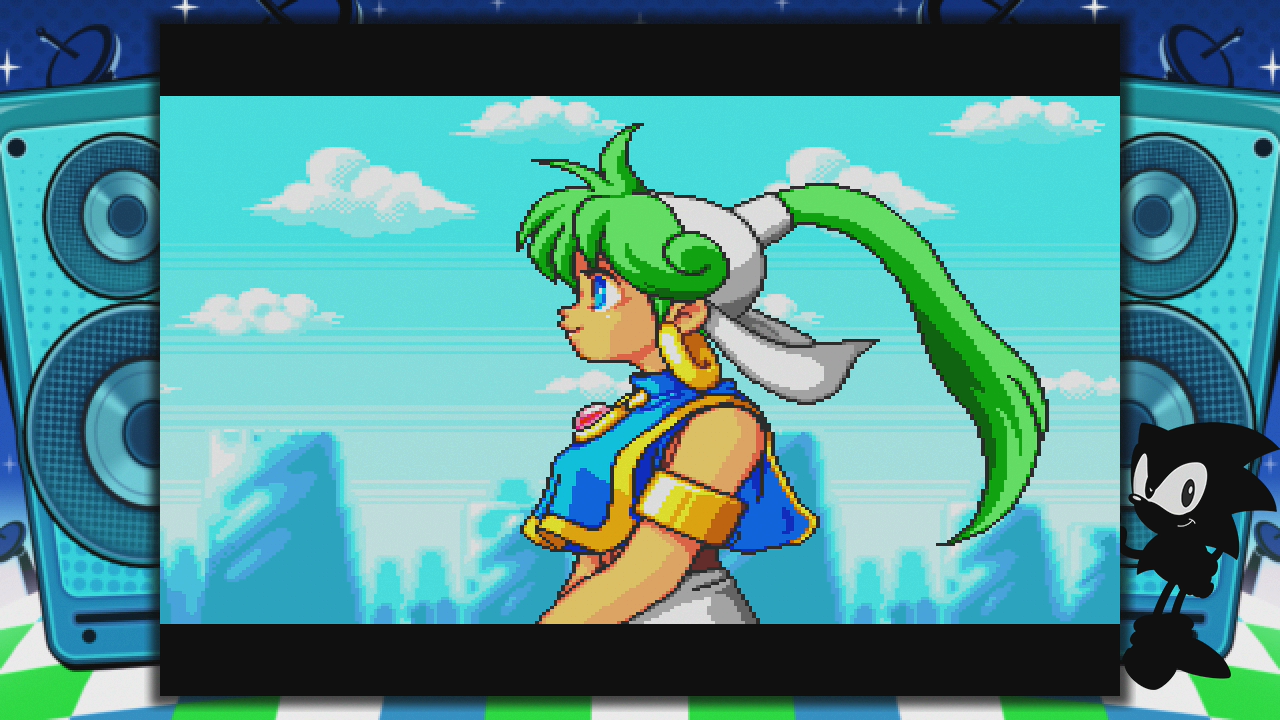
Of course, there is also the matter of Sonic the Hedgehog 2. Sonic the Hedgehog 2 normally runs in 320 x 224 as typical with SEGA Genesis titles, but in 2-player mode, it instead runs in a special 480i mode that basically doubles the vertical lines to 320 x 440. On original hardware, it works like intended, helping preserve the sprite sizes at the cost of slightly stretching the image. However for modern emulators and scaling device, this unusual resolution can cause some problems. These issues range from minor details such as combing artifacts due to poor deinterlacing, to major issues like an emulator or scaling device flat out not loading the picture. This is such an issue that even the developers at M2 gave this mode special attention to prevent potential game breaking bugs. Thankfully none of those issues appears to be on the SEGA Genesis Mini, meaning if you want to annoy your younger brother by swapping places at the last second in a race, nothing is stopping you.
Then there’s the few border options. Similar to the SEGA AGES series recently released on the Nintendo Switch, the system defaults to a rather exotic blue and green background with a Sonic cameo in the background, invoking the often times zany colorful artwork of the Mega Drive advertisements. Despite how garish at first it looks, the use of “cool” colors does prevent potential eye strain, and personally it never got distracting in the same way some of the SEGA AGES borders did. But if you don’t like that, there’s an alternative background that is similarly blue but much more subtle, and of course complete black. The black as weird as it sounds is actually a nice addition, unlike the recent SEGA AGES titles which technically uses a gray gradient background for it’s supposed “none” option. There’s also a 16:9 mode, which is an artificial 16:9 that stretches out the screen. While this picture option is normally frowned on with older games, the SEGA Genesis’ slightly wider screen compared to other consoles at the time like the SNES and TurboGrafx-16 does help make the stretching look a bit less jarring. But it’s still recommended to play using the default 4:3 mode simply to avoid incorrect pixel scaling.
Unfortunately, the “retro” styled filter designed to emulate how an old CRT television would display games is lackluster. The main problem is that there is not gamma boosting whatsoever to compensate for every third horizontal line basically being blanked out. The softness is also, funnily enough, not soft enough to emulate the genuinely terrible composite signal of the original hardware. This means that even with this filter enabled, stuff like the waterfalls or shield powerup in Sonic the Hedgehog aren’t properly “smeared” to disguise the dithering like they would on original hardware. It’s also disappointing that there aren’t other modes available to adjust the picture quality. Like for example, the option to emulate how original hardware ran using the RGB signal, with slightly dimmer coloration and faint jailbars.
One infamous aspect of previous attempts at SEGA mini consoles is the emulation. Specifically the ones from AtGames, which while having a solid lineup of titles in their own right, suffered from really bad emulation ranging from graphics, performance, and sound that effectively killed off any good intentions the machines had. Thankfully with the SEGA Genesis Mini, this problem is entirely avoided. Due to the involvement of M2, who has a long history with helping SEGA with emulation for stuff like the SEGA 3D and SEGA AGES titles on recent hardware, the emulation is generally really good. The graphics are just how you remember them, even retaining some of the same quirks of the original hardware like slowdown and sprite flicker. The sound though, while mostly good, does have some minor issue. There’s a tiny amount of sound lag and some sound effects might sound more shrill or quiet depending on the game. But thankfully it’s so subtle that you likely wouldn’t even notice it.
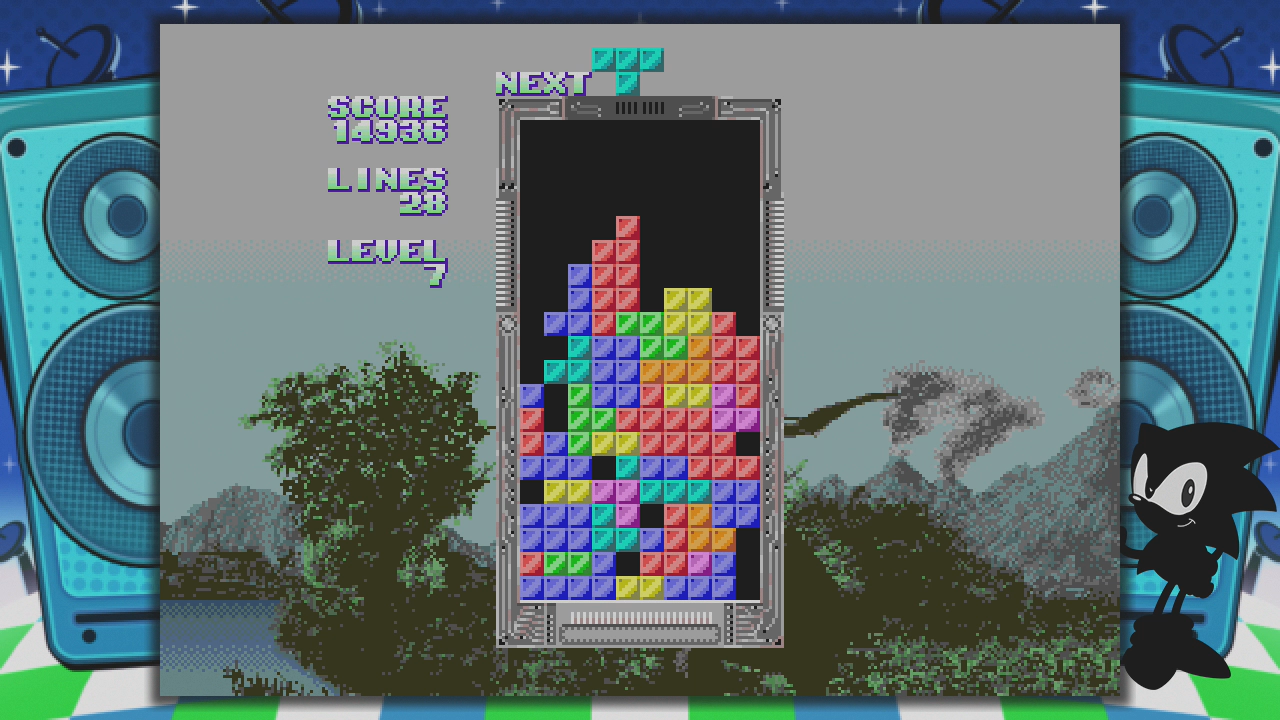
SEGA advertises that the SEGA Genesis Mini has a total of 42 games. While on the surface this does seem true, in reality it’s more like 46 titles, if you factor in Mega Man The Wily Wars is technically 3 Mega Man games plus a bonus Wily Tower segment and the hidden inclusion of Puyo Puyo if you switch over to Japanese. This is also not factoring in games exclusive to other regions, for example the Japanese console getting games such as Puzzle & Action: Tant-R, Madou Monogatari I, and Rent-A-Hero. Even if ignoring the technicalities, 42 games included on the SEGA Genesis Mini is not a bad deal at all, especially when the competition such as the SNES Mini has roughly half the amount of games. The game selection itself having a healthy mixture of popular titles and more niche titles. Along with classics like Sonic the Hedgehog or Golden Axe, you also have games that have more of a small cult following like Monster World IV and Alisia Dragoon. Unlike other SEGA Genesis collections out there, SEGA has also gone out of the way to get approval from other companies like Capcom, Konami, and even Disney to include several third party titles. Notably this means games such as Castlevania Bloodlines, Mega Man the Wily Wars, and Castle of Illusion Starring Mickey Mouse are also included.
What stands out is the fact that a lot of the included games have some sort of significance to the console’s history. For example, several launch titles like Space Harrier II and Alex Kidd in Miracle World, arcade ports like Altered Beast and Columns, games that were at one point bundled like Sonic the Hedgehog and Puyo Puyo, games that were originally a selling point on the SEGA Channel service like Mega Man The Wily Wars, and games that necessitated new hardware like Street Fighter II Special Championship Edition being developed simultaneously with the 6-button controller. It creates a sense of “completion” once you start understanding the context of a lot of these choices. This just factoring in the North American library too, with Japan following a similar type of mentality. Like having two games take advantage of the multi-tap feature such as Yuu Yuu Hakusho: Makyou Toitsusen and Party Quiz Mega Q, Game no Kanzume Otokuyou compiling the SEGA Game Library titles such as Flicky and Teddy Boy Blues, and Madou Monogatari I being the last officially released Mega Drive title.
Though the game selection is overall solid, it does have some holes. For example, there’s no Mortal Kombat title in the collection, there are no games based on celebrities or sports like Michael Jackson’s Moon Walker or NBA Jam despite those being popular with the SEGA Genesis, and possibly other Disney licensed properties like Aladdin or The Lion King (though the Disney Classic Games: Aladdin and Lion King collection compensates for this). Then there’s more subjective omissions, like cult classic titles like Rocket Knight Adventures and Ristar being missing, and games that really push the console’s hardware like Virtua Racing or Panorama Cotton. Plus there’s nothing from the SEGA CD or SEGA 32X, which despite not being exactly popular still had notable games that might of been worth including. Imagine having SEGA CD games such as Snatcher, Lunar: The Silver Star, Popful Mail, and of course Sonic CD also available. But these are all nitpicks in the grand scheme of things, as most of the included titles are solid enough that you’re bound to find at least one favorite.
The two bonus games however, are a bit of a highlight, at least in the context of how unorthodox the release is. On their own, the games Tetris and Darius are nothing special on the surface. If you’re familiar with either, then your not going to get anything “new” out of it. However, both games are basically brand new games created by M2 themselves. Tetris being a port of the arcade game of the same name (yes even having the monkey!), which itself was significant for introducing the major mechanic of lock delays that still influences these type of puzzle games to this day. Granted it technically not being the extremely rare Mega Drive version of Tetris is a disappointment in it’s own right, but having the generally superior arcade version instead does compensate for this. Meanwhile, the Darius port on the SEGA Genesis is flat out brand new, basically filling the hole of it being ported to the SNES and TurboGraphx-16 but not the SEGA Genesis from decades ago. It’s still inferior to the original arcade game due to the natural downgrade from that ultra widescreen to a more standard 4:3 aspect ratio, but it’s still a solid enough game to play through at least once. It’s most comparable to Super Darius on the TurbroGrafx-16, so if you liked that version enough, then this Mega Drive version should similarly please you.
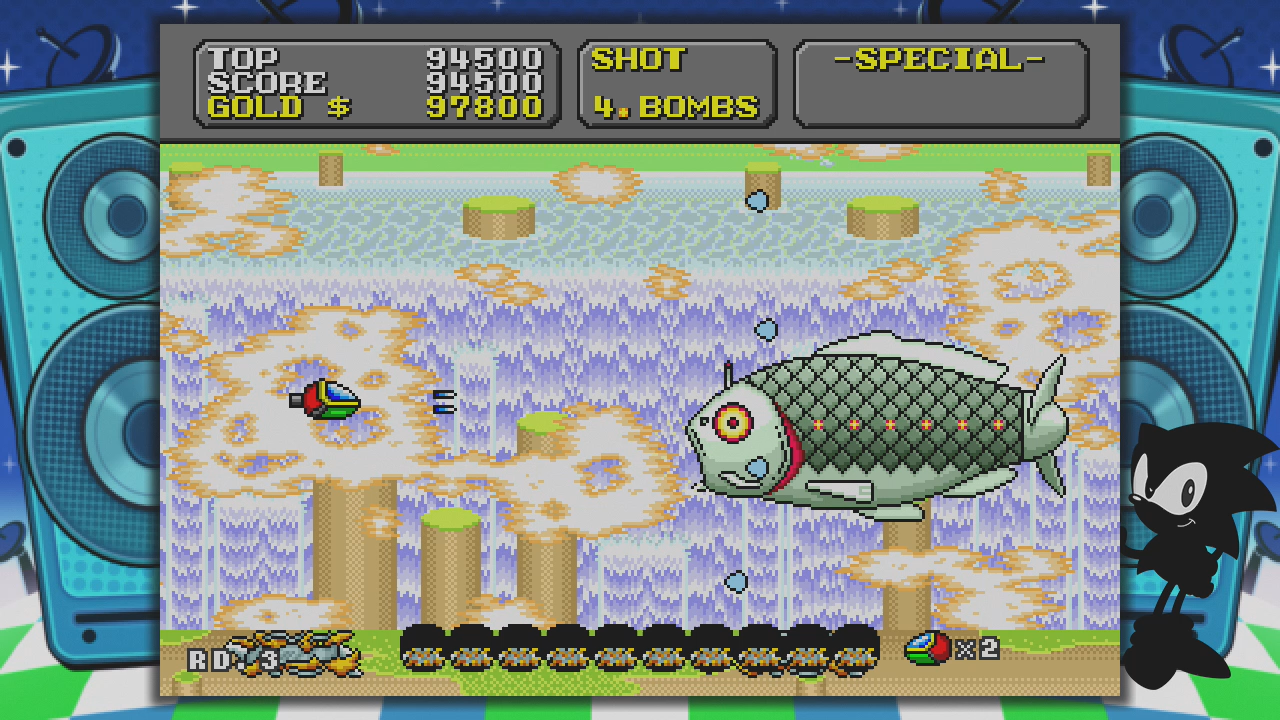
Reviewing every single game in the collection would draw out the review for a lot longer than needed, but there are a few personal favorites I want to still mention. Firstly, the inclusion of Super Fantasy Zone is fantastic. It’s basically the classic Fantasy Zone we know and love, but it’s been polished up with new weapons, stages, and bosses, on top of a fantastic art style and music composition that makes you forget about the color and sound limitations of the SEGA Genesis. Castlevania Bloodlines is a great entry in the Castlevania series, and personally I’d argue it rivals favorites like Castlevania IV and Castlevania Rondo of Blood. I especially love the game from a technical standpoint, like the water reflections from stage 2, the tilting tower from stage 3, and the pseudo-3D animations from the stage 4 boss. The cult classic Alisia Dragoon has a nice presentation overall, but also having a unique gameplay structure. The titular Alisia having powerful weapon in the form of lighting that homes in on nearby enemies on top of different monsters with their own attacks, both of which can be further upgraded with more health and power similar to an RPG in a sense, but the game still puts up a good challenge with the enemy placement and the meter limit of the lightning attack. Gunstar Heroes, which alone is great as a frantic run and gun game, but becomes incredible if you can play it with a friend, which thankfully is very easy to do due to the portable nature of the SEGA Genesis Mini and it coming with two controllers. Finally there’s Shining Force, a great strategy RPG that even people not fans of the genre may like, due to it’s brisk pacing with the combat and interface that is both stylish and simple.
The Japanese Mega Drive Mini also has a handful of exclusives worth mentioning. Rent-a-Hero is a quirky spin on JRPGS, specifically it spoofs both superhero comics and Japanese culture, with a battle system that actually plays out more like a beat ’em up. Aleste MUSHA is a great vertical shmup from Compile, arguably the best game in the Aleste series due to it’s pumping soundtrack, punishing gameplay, and it’s unique blend of ancient Japan and sci-fi elements. Snow Bros. is a great port of the original arcade game, retaining the same frantic snowball tossing gameplay as the original, but also having an additional 20 levels where the princesses get their time in the spotlight to rescue Nick and Tom. Then there’s the games Yu Yu Hakusho Makyō Tōitsusen and Party Quiz Mega Q, which have the distinction of being compatible with a multitap adapter, meaning that up to 4 players can participate in fighting for the former or 5 players answering questions for the latter.
Again, there are just so many good titles to choose from that it’s hard to pick just one. But that highlights how amazing this little box is, a love letter for SEGA fans in a convenient little package. It’s highly recommended you pick up this system yourself, or maybe even give it to a friend or family member that has strong memories of the SEGA Genesis from decades ago. Believe us, it’s definitely worth the investment to play through these old games again, or experience them for the first time!
Positive:
- Lots of attention to detail.
- Solid overall build.
- A lot of good quality titles.
- Overall solid emulation means that there’s no compromises.
Negative:
- Very minor sound emulation and aspect ratio issues.
- Subjective omissions of certain titles.
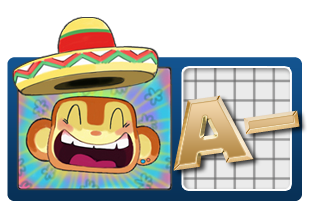 “An amazing little box of SEGA love that comes packed with a strong library of games backed by a lot of attentions to detail.”
“An amazing little box of SEGA love that comes packed with a strong library of games backed by a lot of attentions to detail.”

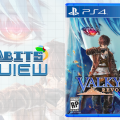
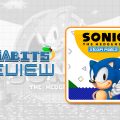
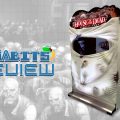
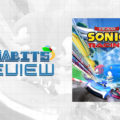
A nice and fair review. It seems the overall consensus is while it has its flaws, the pros clearly outweigh the cons. And it’s nice to see someone acknowledge that while it would be nice to have different titles, including Sega CD and 32X games, it’s subjective and not detrimental to the product unlike some other reviews I’ve seen.
It’d be nice, but I imagine the emulation is different and would require even more time to polish, which probably would be better spent on polishing the existing titles where the audio issues are more noticable. And considering the low sales and bad reputation of both systems that, if we’re gonna be honest here, actually hurt the Genesis brand and Sega’s reputation, it’s probably not something they wanted to dish out the time and money for, especially for a small number of titles for each.
Having said that, it would’ve been fantastic to include as unlockable games or something to see on a Mini Genesis/Megadrive Model 2 with the 32X and Sega CD add-ons attached, but I digress. It’s a neat little package that takes me back to the days of seeing those store kiosks that allowed you to play multiple games on it.
Disappointed about imperfect emulation. I pre-ordered this (still waiting, Europe) expecting real hardware accuracy. This isn’t a 3rd party product and it’s not cheap, there’s honestly no excuse. You know what else has “overall solid emulation” and “very minor sound emulation issues”? Pretty much any emulator out there for basically any device.
So to sum up: The Sega Mini is better than the Nintendo Mini?
It’s the best new classic console on the market now and will be the standard that all classic consoles will be measured by.
Though I’m a bit disappointed that some certain key titles didn’t make the cut as standard, like Alladin and Mortal Kombat – these two were particularly important Mega Drive titles, Mega Drive Alladin was what got Nintendo jealous enough to devise a whole new graphics technique for their Donkey Kong Country series on the S.N.E.S, and Mega Drive Mortal Kombat was the game that got the industry regulated for the first time with age ratings after the congressional hearings in 1993 when Sega and Nintendo both faced it out in court*, and therefore holds political significance for the Mega Drive as well as living up to its ‘Genesis’ namesake in America.
Maybe a few other titles like the Ooze, Ristar and Sonic 3 & Knuckles – this would have made it the best single piece Sonic collection in years, although it should be understood that licence issues are likely the reason why certain titles couldnt have made the cut as standard, but will probably be able to be added in the console later if you have the ROMs, still it’s an extremely stellar line up none the less over all.
* http://www.youtube.com/watch?v=nD-Afpg4P2U
Great review. A real shame though Ristar was left off. That is a classic Sega game.
Not to mention that there is also a third version of the Mega Drive Mini and it’s from Asia. It mixes both Japanese and English games (not all of them, though) and has 4 exclusive titles being Sword of Vermilion, Outrun 2019, Shining Force II & Alien Soldier! The latter two titles are quite a big deal if you ask me.
Other than that, still a nice lineup of games no matter what region or version of the Mega Drive/Genesis Mini console you pick.
To be this good takes AGES, to be this good takes SEGA! Welcome to the Next Level! Sega is love, Sega is life!
I liked that last statement, Laurence J. Nguyen. Very well put!